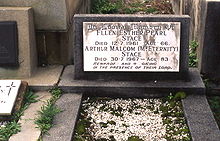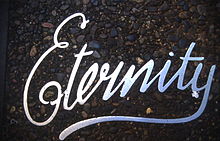- Arthur Stace
-
Arthur Malcolm Stace (9 February 1884 – 30 July 1967), otherwise known as Mr Eternity, was an Australian reformed alcoholic who converted to Christianity and spread his form of gospel by writing the word "Eternity'" in chalk on footpaths in Sydney over a period of approximately 35 years.[1] Only four known photographs of Stace exist, all of which were taken by Trevor Dallen for the Sydney Sun.
Contents
Early years
Stace was born in Balmain, in the inner-west of Sydney. The child of alcoholics, he was brought up in poverty. In order to survive, he resorted to stealing bread and milk and searching for scraps of food in bins. By the age of 12, Stace, with virtually no formal schooling, had become a ward of the state. As a teenager, he became an alcoholic and was subsequently sent to jail at 15. Afterwards, he worked as a "cockatoo" or a look-out for a Two-up "school". In his twenties, he was a scout for his sisters' brothels. At age 26, in March 1916 enlisted for the Great War (World War One) with the 19th Battalion 5th Brigade AIF, entering with the 16th Reinforcements, service number 5934. Suffered recurring bouts of bronchitis and pleurisy which led to his medical discharge 2nd April 1919.
Conversion to Christianity
Stace converted to Christianity on the night of 6 August 1930, after hearing an inspirational sermon by the Reverend R. B. S. Hammond at St. Barnabas Church, Broadway. Inspired by the words, he became enamoured with the notion of eternity. Two years later, on 14 November 1932, Arthur was further inspired by the preaching of evangelist John G. Ridley[2], MC on "The echoes of Eternity" from Isaiah 57:15:
"For thus saith the high and lofty One that inhabiteth Eternity, whose name is Holy; I dwell in the high and holy place, with him also that is of a contrite and humble spirit, to revive the spirit of the humble, and to revive the heart of the contrite ones."
John Ridley's words,"Eternity, Eternity, I wish that I could sound or shout that word to everyone in the streets of Sydney. You've got to meet it, where will you spend Eternity?" proved crucial in Stace's decision to tell others about his faith. In an interview, Stace said, "Eternity went ringing through my brain and suddenly I began crying and felt a powerful call from the Lord to write Eternity." Even though he was illiterate and could hardly write his own name Arthur, legibly, "the word 'Eternity' came out smoothly, in a beautiful copperplate script. I couldn't understand it, and I still can't."
After eight or nine years, he tried to write something else, "Obey God" and then five years later, "God or Sin" but he could not bring himself to stop writing "Eternity".
The Sydney City Council brought him to the attention of the police as they had rules about the defacing of pavements, so much so that he narrowly avoided arrest around twenty-four times. Each time he was caught, he responded with, "But I had permission from a higher source".
Several mornings a week for the next 35 years, Stace left his wife, Pearl and their home in Bulwarra Road, Pyrmont around 5am to go around the streets of Sydney and chalk the word "Eternity" on footpaths, train station entrances and anywhere else he could think of. It is estimated that he wrote the word around 500,000 times over the 35 years. Workers arriving in the city would see the word freshly written, but not the writer, and so, "The man who writes Eternity" became a legend in Sydney. The mystery was solved when Reverend Lisle M. Thompson, who preached at the church where Stace worked as a cleaner, saw him take a piece of chalk from his pocket and write the word on the footpath. Thompson wrote about Stace's life and an interview was published in the Sydney Sunday Telegraph on 21 June 1956.
In 1963, photographer Trevor Dallen cornered Arthur and asked to take a few pictures of him writing his famous phrase. After four photos, Trevor ran out of film and asked for Stace to stay put while he got more film. Upon Trevor's return, Stace was gone.
 Stace's grave in Botany Cemetery
Stace's grave in Botany Cemetery
Stace died of a stroke in a nursing home at the age of 83 on 30 July 1967. He bequeathed his body to the University of Sydney; subsequently, his remains were buried with those of his wife at Botany Cemetery (General 15, no. 729) around two years later.
The National Museum of Australia in Canberra holds one of Stace's iconic 'Eternity' signs, which he chalked on a piece of cardboard for a fellow parishioner. The museum also has an Eternity gallery, inspired by Stace's story. The gallery features 50 personal stories from ordinary and extraordinary Australians. The stories are tied together by emotional themes including joy, fear, separation, chance and loneliness, which are all elements of Stace's story.
In Sydney today, the word "Eternity" can still be seen written in three places:
- On Stace's gravestone in Botany Cemetery.
- Inside the bell in the GPO clock tower which had been dismantled during World War II. When the clock tower was rebuilt in the 1960s, the bell was brought out of storage and as the workmen were installing it they noticed, inside, the word "Eternity" in Stace's chalk. This is the only surviving "Eternity" by Stace's own hand in Sydney. (No one ever found out how Stace had been able to get to the bell, which had been sealed up).
- In Town Hall Square, between St Andrew's Cathedral and the Sydney Town Hall. When the area was redeveloped in the 1970s, a wrought aluminium replica of the word in Stace's original copperplate handwriting was embedded in the footpath near a fountain as an eternal memorial to Stace.
As a tribute to the man known as Mr Eternity, the Sydney Harbour Bridge was lit up with the word "Eternity" as part of the celebrations for the beginning of the year 2000.[3]
The Eternity Man is an opera based on Stace's life, written by Jonathan Mills to a libretto by Dorothy Porter. This was adapted in 2008 into a film directed by Julien Temple.[4]
References
- ^ "Stories from the emotional heart of Australia". National Museum of Australia. http://www.nma.gov.au/exhibitions/now_showing/eternity/stories_from_the_emotional_heart_of_australia/.
- ^ Arthur "Mr Eternity" Stace (1884–1967)
- ^ Powderbomb Website
- ^ Limelight, January 2009, p. 35
External links
- "Dictionary of Sydney", resources by Shirley Fitzgerald 2008
- The Life & Legacy of Mr Eternity, resources by Peter Rahme
- Eternity, a tribute to Arthur Stace
- The story of Arthur Stace
- A simple tribute to the life of Arthur Stace
- Listen to the song "Mr Eternity" by Jim Low and read the article, "Mr Eternity: Arthur Stace"
- Mr Eternity, an interview with Arthur Stace
- The Eternity gallery at the National Museum of Australia
- The Life & Legacy of Mr Eternity – The song by Peter Rahme
Categories:- 1884 births
- 1967 deaths
- Converts to Christianity
- Australian graffiti artists
- Australian Christian missionaries
- People from Sydney
- History of Sydney
- Australian Baptists
- Deaths from stroke
Wikimedia Foundation. 2010.

